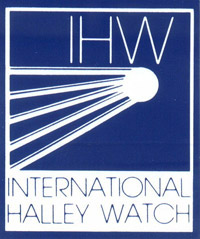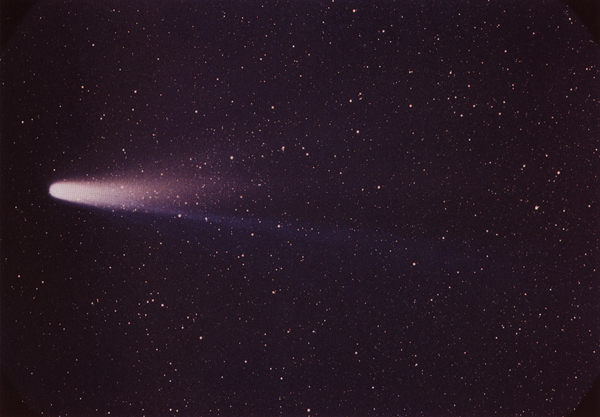C7 And The International Halley Watch Large Scale Phenomena Network
In 1984 Company Seven was approached by NASA to discuss the possibility of providing several specialized imaging telescopes to create a world wide network so that NASA could continuously document the visit of Comet Halley in 1986. The results of our collaboration are now a small part of science history.
Comet Halley (or '1P/Halley') is the first known comet that periodically approaches Earth. It is has been well documented over at least two millennia as it passes close enough on its travels through space so that it can be seen from Earth with the naked eye. The first known mention of it was in Chinese chronicles of May 240. Since then the comet's visit every seventy-five to seventy-six years has been documented, and often coincided with some significant events of world history. It has since been named after astronomer Edmond Halley who observed the comet in 1682. After studying records of his predecessors Halley was the first to recognize this to be a periodic comet, and published an accurate prediction of its return in 1758.
 The International Halley Watch (IHW) grew out of a National Aeronautics and Space Administration (NASA) sponsored study conducted from 1979 to 1980 (Brand, J.B., Newburn R., Friedman, L., 1980). The premise behind that study was that some form of cooperation among the astronomers and space scientists of the world would be necessary to make the most of the opportunity to study Comet Halley. In 1980 NASA organized a Lead Center for the western hemisphere at JPL under Ray Newburn. A similar facility for the eastern hemisphere was organized at Dr. Remeis Sternwarte, Bamberg, under Juergen Rahe with the support of the government of the Federal Republic of Germany. Newburn and Rahe elaborated upon the plans of the original study group, which suggested appointment of specialists to set up networks of observers in each of the major observing disciplines, establishment of an international oversight committee, coordination with the planned space projects, and cooperation with amateur observers. On 1 September 1980 the National Aeronautics and Space Administration (NASA) authorized a science mission.
The International Halley Watch (IHW) grew out of a National Aeronautics and Space Administration (NASA) sponsored study conducted from 1979 to 1980 (Brand, J.B., Newburn R., Friedman, L., 1980). The premise behind that study was that some form of cooperation among the astronomers and space scientists of the world would be necessary to make the most of the opportunity to study Comet Halley. In 1980 NASA organized a Lead Center for the western hemisphere at JPL under Ray Newburn. A similar facility for the eastern hemisphere was organized at Dr. Remeis Sternwarte, Bamberg, under Juergen Rahe with the support of the government of the Federal Republic of Germany. Newburn and Rahe elaborated upon the plans of the original study group, which suggested appointment of specialists to set up networks of observers in each of the major observing disciplines, establishment of an international oversight committee, coordination with the planned space projects, and cooperation with amateur observers. On 1 September 1980 the National Aeronautics and Space Administration (NASA) authorized a science mission.
Right: International Halley Watch logo (30,339 bytes).
In 1981 a Steering Group of 22 scientists, residents from 12 countries was appointed by NASA to help establish the other parts of the IHW and to advise on its operation. Later this international group became independent of NASA, elected its own chairman, and added and/or replaced members as it felt necessary. The Steering Group selected Discipline Specialists based on formal proposals submitted in response to a NASA letter, mailed worldwide, seeking cometary scientists to organize the observing networks, coordinate their activity, and later to assist in archiving the resulting data. By the time of the 1982 IAU meeting a complete administrative organization was in existence, awaiting its acceptance and imprimatur by that worldwide group. The team concluded that amateur astronomers were by then so accomplished with experience and suitable technology, that it would invite contributions of observations and images to support the effort. Among the aspects to be developed was the Large-Scale Phenomena, part of which consisted of an international network of similar focal length, fast telescopes designed to image the comet around the clock from sites in the southern hemisphere.
Early in 1984 Company Seven was approached by Dr. Malcom B. Niedner of NASA Goddard Space Flight Center, Greenbelt, Maryland to fashion a telescope system that could be used by people with modest training to image Comet Halley from 1985 through 1986. The decision was made to employ Schmidt-Camera telescopes of 20 cm aperture, a fixed focus very fast specialized catadioptric telescope arrangement that is suitable only for photography with film. NASA could have contracted these to be made by any number of larger companies than Company Seven, but time was short and they needed a company with experience and that could be agile enough to adapt to changing and increasing requirements - and one that could work well within the budget constraints.
These Schmidt-Camera telescopes accept one frame of 35mm film at a time, loaded by hand in a dark environment (Dark Room) before each exposure. Focus is set in an optical laboratory before these instruments were sent to overseas. Construction techniques and materials, including Invar framing keeps the focus from changing appreciably with temperature. These Schmidt-Cameras have no shutter mechanism in the conventional sense, to take an image the lens cover is removed and replaced when finished. To keep exposure times to a minimum, 400 ASA print film was selected and was 'hypersensitised' before use; a method popular among astrophotographers of the period where film was conditioned in advance of use within a heated vaccum chamber filled with a Hydrogen Forming Gas. Company Seven retains in our museum collection the larger chamber specifically made to support this research and development efforts of this mission.

Above: typical Schmidt-Camera telescope arrangement.
Light enters through Corrector lens at right, reflects off Primary Mirror at left and
and is captured on Film Holder within the instrument (58,386 bytes).
Each of these telescopes would be optimized for the task and installed onto a motorized Fork Mount with Equatorial Wedge to permit Pole Alignment and continuous tracking and photography of the comet. NASA's budget allowed for only so many instruments to be made but after considering the historic significance of the project Company Seven volunteered to provide an additional system. We were motivated in part because the last instrument, should we make it available, would be assigned to for use at Easter Island in the Pacific and operated by Dr. William Liller. Dr. Liller is man whom we respect, an experienced observational astronomer since retired as professor and Chairman of the Astronomy Department at Harvard University. So while the NASA mission budget did not allow for the acquisition of this final instrument, Company Seven included it essentially "buy x, get one free".
The 20cm Schmidt Camera telescopes were completed, optimized and focused on time and ahead of schedule so that we were able to perform the final check out, one by one, at the NASA GSFC Optical Test Facility (GORF). And over this period the operating manual to accompany each instrument and the film hypersensitizing equipment was written by Dr. Niedner. As it turned out this last telescope would be the most accomplished since Dr. Liller was able to take astrophotographs of Comet Halley over forty consecutive clear nights! His photos captured comet tail 'disconnection event', where the tail of the comet detached and drifted away as a new tail formed. This helped NASA to better understand solar wind dynamics and other dynamic aspects of space.

Above: Comet Halley on 8 March 1986. Image taken by Dr. William Liller at Easter Island.
The original negative was scanned decades ago hence the checker pattern that may be seen when enlarged.
A 16 x 20" print is displayed at Company Seven's showroom. NASA Image Catalog No. LSPN-1725 (235,951 bytes).
Click on image to see enlarged view (1,034,677 bytes).
The volumes of data gathered about Comet Halley kept the NASA team members busy working to document and assess the information until the mission formally concluded on 30 September 1992. The Archive of Periodic Comet Halley has been compiled and is available in a CD-ROM or digital version. The comet's reduced observations belong to one of the following disciplines or networks:
-
1. Astrometry.
2. Infrared Studies.
3. Large-Scale Phenomena.
4. Near Nucleus Studies.
5. Photometry and Polarimetry.
6. Radio Studies.
7. Spectroscopy and Spectrophotometry.
8. Amateur Observations.
9. Meteor Studies
The data remains available from NASA (as does the image above) and no doubt it will continue to be referred to and studied for generations to come.
It was a privilege meet and to work with Dr. Niedner and Dr. Liller, and the NASA team on another historic mission. Dr. Liller resides in Chile where he continues making contributions to science as a "born again amateur astronomer" and member of the International Astronomical Union. Dr. Niedner remains at NASA-GSFC. Maybe someday Company Seven will recover one of these instruments sent to far off lands, and add it to our museum collection?
Contents Copyright 1994-2009 Company Seven All Rights Reserved, all space and HST images courtesy of NASA.

